Poolish Focaccia
I’ve baked bread for four days straight. In fact, the only reason I’m not baking today is, well… I ran out of flour.
I’m not exactly sure what came over me. I’ve always liked baking bread, but I usually only do it a few times a year, and I never spent too much time thinking about it. Make the dough, put it in the oven, and eat, right? And it might not be the best bread ever, but unless I really messed it up, fresh bread is always edible, even if it’s not exceptional.
But I started thinking about bread, and whole grains, and I decided to buy a grain mill. So I can grind my own flour. Thank goodness I live on the third floor of a house in a city with no yard or I might try to grow my own wheat. Somehow I don’t think the second bedroom is up to the task.
To prepare for the mill (It’ll be three weeks or so before it arrives), I finally purchased the two books I’ve been coveting for a while: The Bread Baker’s Apprentice, and Whole Grain Breads both by Peter Reinhart. I’ve been working from the former over the past few days. I figure I should get comfortable with white flour before I move on to whole wheat. I must say, I’ve been more than delighted. These books will be–and already are–indispensable. If the idea of being a HUGE breadgeek who makes the tastiest baked goods in town is appealing to you, definitely drop $40 on these two beautiful, huge, detailed hardbound books.
I’m going to share the Poolish Focaccia from Bread Baker’s Apprentice with you, because it’s one of those breads that isn’t that hard, but involves enough new skills for a green baker without being over-challenging. It does require a lot of time to make, but if you’re looking to expand your baking skills, and have a LOT of really tasty, perfectly golden brown, deliciously herbed focaccia when you’re done, than this recipe is for you! It’s a perfect weekend project.
I’m going to share a ton of photos, so before I get bogged down in the details, here’s the overview:
Day One: The night before baking, you make the poolish. All this requires is mixing flour, water and yeast and letting it ferment on the counter for a few hours, or even overnight. You can make focaccia without this step, but I think it gives it extra flavor, and it’s a good trick to learn for other breads. Taking a few minutes to do this before you go to bed really gives a great boost to your bread the next day. You can make the herb oil on either day.
Day Two: Mix the poolish with flour, water, salt, oil and yeast to make the dough. Turn the dough out on the counter and fold it. You’ll fold the dough three times, with rising in between foldings. After the dough has risen, you plop it onto a baking sheet and shape it, let it rise, then shape again before baking. A generous total time estimate would be 4-5 hours, but most of that is rising time.
Poolish
2 1/2 Cups (11.25 oz) Unbleached Bread Flour
1 1/2 Cup (12 oz) Water, room temperature
1/4 tsp Instant Yeast (Like RapidRise)Poolish Focaccia
3 Cups (20 oz) Poolish
2 2/3 Cups (12 oz) Unbleached Bread Flour
2 tsp Salt
1 1/2 tsp Instant Yeast (RapidRise, for example)
6 Tbs (3 0z) Olive Oil
3/4 Cup (6 oz) Water, 90-100º F (lukewarm)
1/2 Cup Herb OilHerb Oil
1 Cup Olive Oil, warmed to 100º F (ish)
Any herbs, 1/2 Cup fresh chopped or 2-3 Tbs dried, or a combination
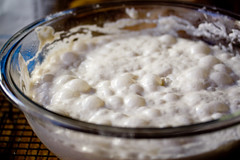 The Night Before: Make the poolish. With a wooden spoon, mix the ingredients together until all the flour is hydrated, and you’ve got a smooth, sticky mass. It’ll look like very thick pancake batter. Cover with plastic wrap. You can leave it out on the counter for four hours and then refrigerate, or leave it out all night. I left mine outside overnight where it was warmer than the fridge, but cooler than the house, so the poolish would have a nice, steady but slow ferment. Either way, it should be nice and bubbly after fermenting, like the photo on the left. It will have a super cool springy/stringy/stickty consistency, too.
The Night Before: Make the poolish. With a wooden spoon, mix the ingredients together until all the flour is hydrated, and you’ve got a smooth, sticky mass. It’ll look like very thick pancake batter. Cover with plastic wrap. You can leave it out on the counter for four hours and then refrigerate, or leave it out all night. I left mine outside overnight where it was warmer than the fridge, but cooler than the house, so the poolish would have a nice, steady but slow ferment. Either way, it should be nice and bubbly after fermenting, like the photo on the left. It will have a super cool springy/stringy/stickty consistency, too.
(You can also make the herb oil this same night: Mix the herbs with the warmed oil. Turn off the heat and let the herbs infuse the oil at room temperature. The oil can also be made the next day, and this is noted later on in the directions.)
Make the Dough
If you refrigerated your poolish, take it out and let it sit for an hour to warm up. Once warm, it’s time to make the dough.
Mix the flour, salt and yeast together in a large bowl (or in the work bowl of a stand mixer). Add the poolish, water, and oil. It’ll look something like this:
If mixing by hand, mix to combine all the ingredients and then get in there and beat the hell out of it for 10 minutes. The book suggests 3-5 minutes, but it took me longer. It’s done when the dough is smooth, crazy sticky, willing to pull off the sides of the bowl but not the bottom, and your arm aches. This is what it looks like halfway through mixing – here it’s still rough and bumpy. It’ll be too wet to knead.
If mixing by machine, start with the paddle attachment to combine at low speed for 2-3 minutes, then switch to the dough hook. Beat at medium speed for 5-7 minutes. The dough should clear the sides of the bowl but stick to the bottom. Add more flour or water if needed to achieve this.
Stretch and Fold
Prepare a bed a flour on your work surface. Scrape the dough out of the bowl onto your flour bed. Sprinke the top of the dough with flour.
Pat the dough into a roughly rectangular shape. The patting serves three purposes: it pushes the dough out into a rectangle, distributes the flour over the top, and removes excess flour. There should be enough flour that the surface of the dough is no longer sticky, but just enough to accmplish that. Patting removes the excess. Let the dough rest for 5 minutes.
Now you’ll be folding the dough like a letter. Pick up one side of the dough. As you do this (it’ll be hard to hold on to, do the best you can), stretch the dough out and fold it over towards the middle. The quicker the movement, the easier it will be. If the dough is sticking to the table, no worries. Use a dough scraper to lift up the edges of the dough to put more flour underneath, seen here.
Repeat with the other side, again, just like you’re folding up a letter.
The dough, having been folded in thirds, looks like this. The dough should stay about the same dimensions after each fold. You’re not folding it into smaller and smaller rectangles, but stretching the dough out and then folding it back in on itself to make similarly sized rectangle. If that makes any sense?
Brush or spray the dough with oil, cover in plastic wrap, and let sit for 30 minutes. You’ll the fold it again, oil, cover, let sit for 30 minutes, then fold it a third time. Each time you fold, the dough will be easier to work with, a little firmer, a little neater. Fold in the opposite direction then the last. For example, if you folded left to right, the next fold will be top to bottom. This is the second fold:
Rising and Shaping
After the third fold, let the dough sit covered on the counter for 1 hour. The dough will rise, but not necessarily double in size. If you didn’t make it the night before, you can prepare the herb oil during this rise. Mix the herbs with the warmed oil. Turn off the heat and let the herbs infuse the oil.
Prepare a 17 x 12″ baking sheet (with sides, like a jelly roll pan) by placing a layer of parchment paper down across the bottom. Oil the parchment.
As best you can, move the dough from the counter to the baking sheet, trying to maintain the rectangle shape. Don’t worry if you can’t get a clean move, the dough is soft and unwieldy, so just move it the best you can.
Pour about 1/4 Cup of Herb Oil over the top.
Using only your fingertips, begin to press into the dough to distribute the oil and flatten the dough out. The dough will gradually spread out in the pan, but don’t worry if it doesn’t fill the pan, it’ll get there after rising again. Just remember that you’re only allowed to use your fingertips, pressing down. You want to keep the majority of the air bubbles that have been forming in the dough all this time, so kneading or pressing the dough flat with your hands would destroy all your hard work.
Make sure the dough is completely covered in oil, then cover and let it rise for two hours. It will be very puffy, and if it hasn’t completely filled the pan, it’ll be close to doing so. Nearing the end of this rise, preheat the oven to 500º F, making sure the rack is in the middle.
Add another 1/4 cup, or more, of the herb oil.
Spread the dough out to its final size using the same fingertip technique as above. You’ll see all sorts of fun bubbles! You want an even distribution of bubbles and fingertip dimples. You might want to break any huge bubbles since they’ll just explode in the oven anyway. Sprinkle the top with salt as desired.
Baking
Let the dough rest for another 10-15 minutes. Place the dough in the oven, and turn the temperature down to 450º F. Bake for 10 minutes, rotate the sheet for even baking, then bake for an additional 10-15 minutes until golden brown. If you have an instant read thermometer, the dough should be 200º F in the center of the pan.
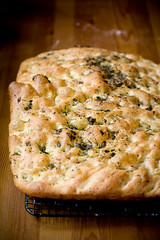 Cooling and More Ideas
Cooling and More Ideas
When the focaccia comes out of the oven, remove it from the pan and place it on a cooling rack. Let the focaccia cool for at least 20 minutes before gorging yourself.
Feel free to top your focaccia with other things besides just herbs! Olives are nice, as well as sliced onions, garlic… I’ve seen sweet focaccia with grapes or apples and cinnamon and sugar… the possibilities are endless. Depending on the topping, you may want to add it in the last five minutes of baking to ensure it doesn’t burn.
Enjoy your ridiculously huge loaf of focaccia. Bring one to the next party you attend and you’ll be everyone’s favorite person.
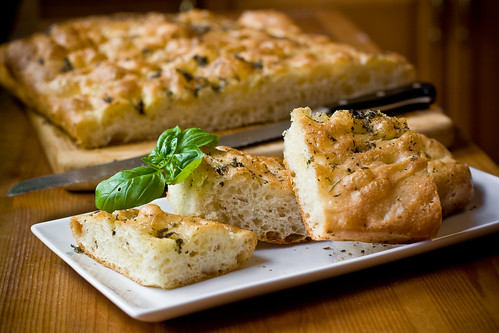
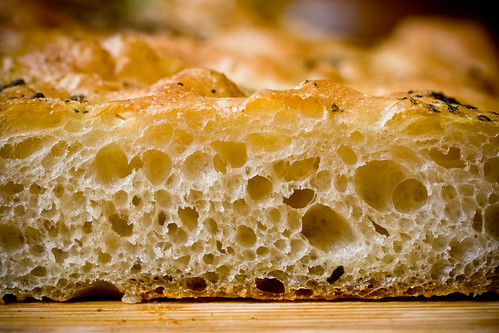
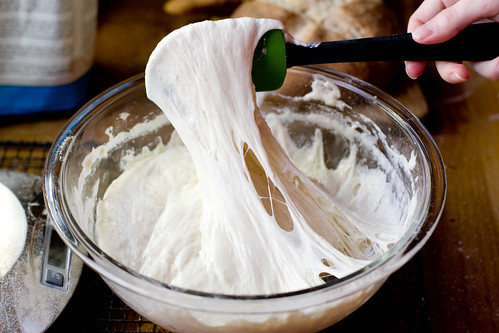

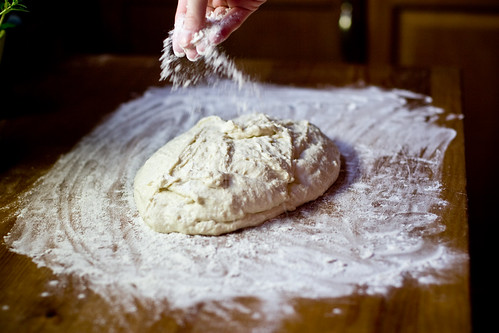
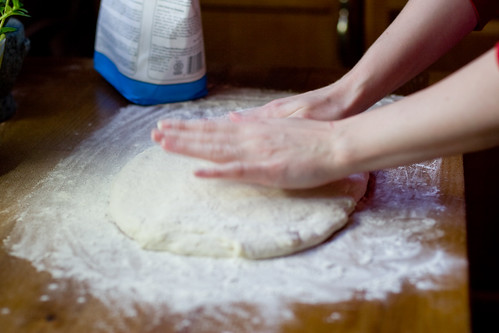
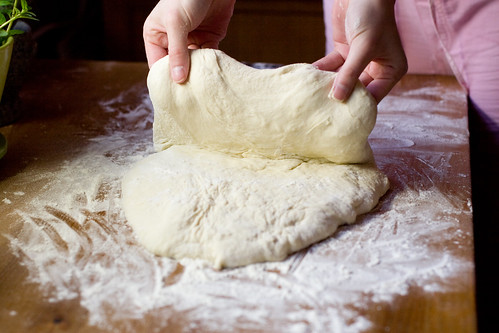
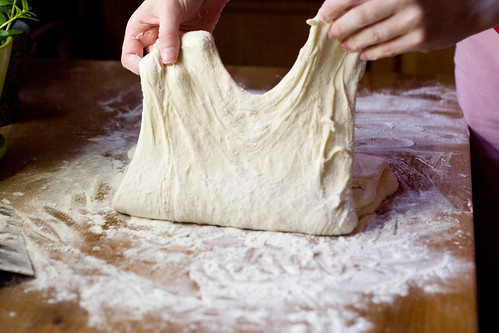
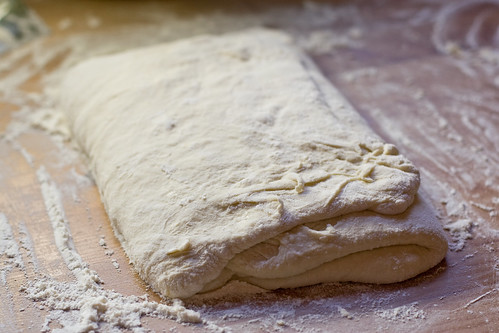
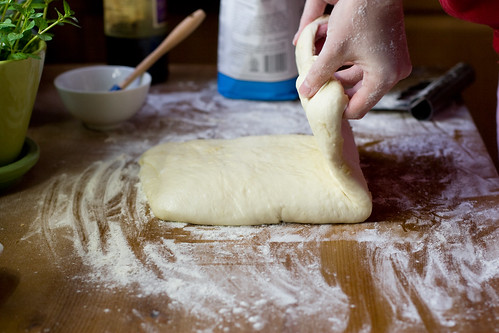
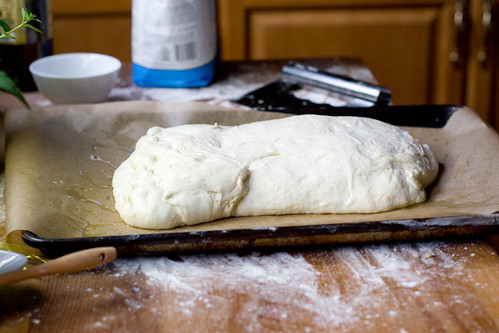
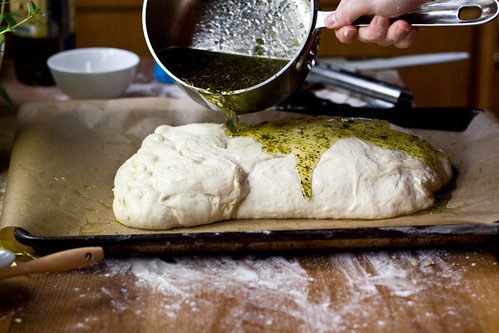

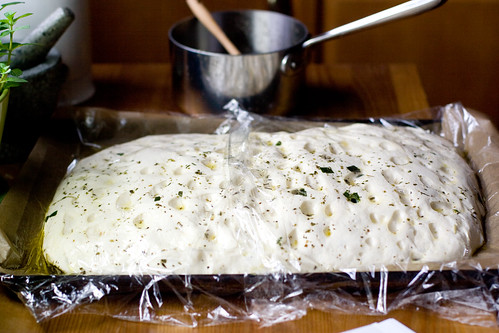
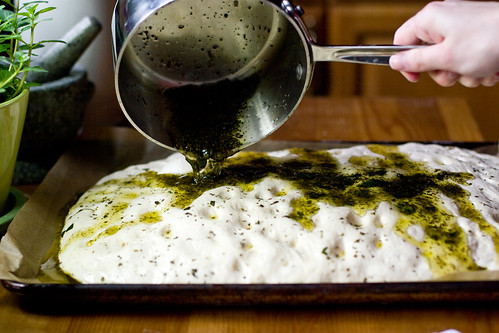
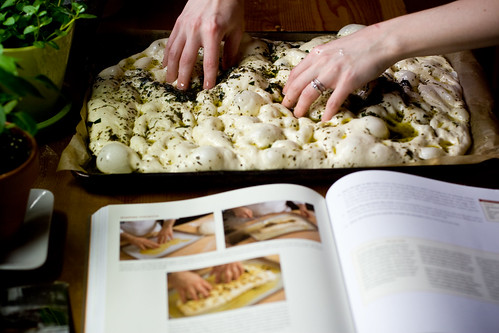

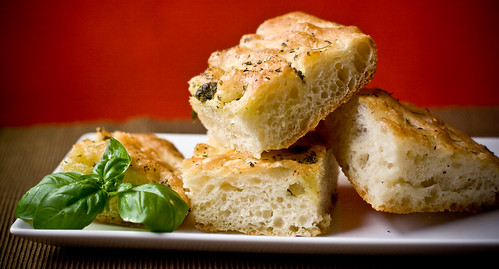
It looks beautiful inside! I can smell it right now.
Your bread looks amazing. Did you eat it plain? Make sandwiches? I wish it was the weekend now, so there would be time to ake this too…
Wow that’s a lot of work for focaccia, but it looks delicio. I started making more focaccia lately too because it’s so easy. I don’t do so many risings though. I just make the poolish/sponge the night before, let it ferment for a day, then mix it in with the rest of the flour, water, oil and salt to form the dough, let it rest/double for an hour, then shape it, dimple it, let it rest for another half hour, and then pour on the oil and bake.
Wow, I commend you for going through all that to make the focaccia – it looks MARVELOUS!!! Hope you’re able to rest after all the bread-baking you’ve been doing lately!! :0)
Looks awesome. I have also been on a bread kick this month and have been eyeing the Reinhart book. I love the sense of accomplishment that comes from creating amazing bread. I am trying this recipe ASAP.
This seems to be a great recipe for focaccia! I think I will try it out sometime, as I’ve always wanted to make it. Though I will probably cut it down and use a smaller pan. Mmm, your photos are so appetizing!
Beautiful as always Lolo!
What grain mill did you buy?
I bought the Country Living Grain Mill. It’s manual!
This looks AMAZING! I’ve always used the Garlic Rosemary recipe from Gourmet but this looks really good and the technique is interesting.
Wow, what a great tutorial! Thank you!
i have the apperentice baker book too!. That book is AWESOME. Nice pics!
Oh my god, that looks amazing! I can’t wait to get home and try this.
yummmmmmmm.
Oh my GOD that looks so insanely good. I think I could eat up every photo on this whole page. Mmmm. Focaccia is one of life’s greatest joys. When I lived in Florence Italy, I knew just when the corner bakery would take their bread out of the oven… and I loved to buy a big slab of warm foccacia. So yummy.
Very wonderful blog! Lots of amazing recipes! I will surely check in regularly.
nice ^_^ it looks delicious!
Mmmm, that looks amazing!
Your very own mill, wow! That’s an investment I’d like to make some day. Your post has convinced me that I really need both of Reinhart’s books though I hardly make bread. It’s like an annual activity for me.
Thanks for the great entry- this looks like something I will try soon! I’ve also been on a bread kick (I have some rising in the kitchen now!). I have been eyeing mills, but need to wait for a little fundage…
Do you think you could divide this up after cooking and freeze it?
That looks so. flipping. delicious. Nice action shots!
I’ve just found your blog. As a new vegan and committed food lover, I cannot tell how in love I already am with your site! And bread. You needn’t say anything else. I’m there. What gorgeous pictures. Everything looks delicious. Awesome job. I’ll definitely be back regularly! :)
Can’t wait to get my hands dirty making this! Thanks. I love your site!
Wow, great timing! I decided about a week ago that my next kitchen purchase is going to be a baking stone to put in the oven. I’ve made bread before at home, but it always lacked that bakery greatness. I’m hoping a baking stone will help out with that. The focaccia looks great, by the way. I may need to be the next bread i try!
Hi,
Found your site when I was surfing. But I can tell you that grinding or milling your own flour is great. I keep mine in a plastic baggie in the freezer and just pull out what I need for the next day the night before so they can warm up. That way the flour does not go rancid.
Great post, great pictures as always! All of Peter Reinhart’s books are great. Have you found his blog?
http://peterreinhart.typepad.com/
Very cool post!
Focaccia is one of the few breads that I actually enjoy making – otherwise, I’m not really much of a baker…
Anyway, I love your pics (as usual!) & that method of pouring herb oil on top of the bread is great. I typically make pesto focaccia, which involves spreading the pesto on top of the bread, so it never occurred to me to make it like that. Yum!
Thanks for inspiring me to break out the flour & get to work!
Your shortbread was a hit at the garden sale! Thank you! We made several hundred dollars that day – enough to put in a willow fence. :-)
Isn’t baking bread the best! I love making bread every weekend. It’s a nice way to end / start the week.
Your tutorial is beautifully presented and illustrated. I can’t wait to try this. I <3 your blog!
Oh. My. Goodness. I just made this recipe today and it made me feel like a genius breadmaker! The texture is amazing; the flavor is amazing. Thanks so much for the photos. Every time I thought I might be going wrong, I checked the photos and my bread looked like the pictures, so I relaxed and kept on.
Yes, it’s time consuming, but it’s not all that much actual work (except for the initial mixing). If it’s a day you’re going to be home anyway, give it a try. It is totally worth it.
That bread looks gorgeous! Definitely a project for the weekend – I’ve only ever tried “making” bread using a machine, and it never tastes particularly exciting. I bet this one would make a great side dish with some really tomatoey pasta. Mmmm!
Mmmm, this looks so good! I can’t wait to try this recipe! I have the Poolish sitting out now. :)
I just had the best Focaccia at Todd English’s Blue Zoo restaraunt at disney in Orlando. They also had a nice thin crisp bread which was made with a melted cheese. I forgot what that was called.
I made this today! It was so good! Your pictures helped SO much, I could always tell I was on the right track. :) This is only the 2nd recipe I’ve tried from your site, but I’m definitely gonna do a bunch more now! Amaaazing! :)
Oh my that looks beautiful!
I think I must try and make some.
i actually want to cook everything on your blog.
I just finished making this yesterday afternoon and it’s already all gone thanks to my roommates! They couldn’t believe it was vegan! Thanks for posting this great recipe. I’ll be trying out the apple tart today.
we made focaccia from this formula in pastry school. i loved bread baker’s apprentice. awesome book.
Thanks for the recipe. I just made it and it’s sooooo yummy. All that work was worth it!
your focaccia looked so amazing i knew i had to make it! last saturday i had some time on my hands and did just that.
thanks to your wonderful instructions, and photos to accompany, was a great success!!! this made for the best focaccia i’ve ever had. hands down. seriously. :) i don’t think i can ever purchase focaccia again – i’m going to be making it myself from now on – it’s just that darn awesome!
thanks again for the recipe, and for such a stellar site!
your focaccia looked so amazing i knew i had to make it! last saturday i had some time on my hands and did just that.
thanks to your wonderful instructions, and photos to accompany, was a great success!!! this made for the best focaccia i’ve ever had. hands down. seriously. :) i don’t think i can ever purchase focaccia again – i’m going to be making it myself from now on – it’s just that darn awesome!
thanks again for the recipe, and for such a stellar blog!
Thanks .. this was great will never buy it again..I added carmalized onions and crushed garlic then topprd it with fresh grated romano cheese, ..was our of sight with your poolish.. first time I tried it ..now is only way to go!!!!
Lolo, delicious looking focaccia! I found your blog by searching for others who had used Reinhart’s recipe, having just tried the recipe myself. My dough was a bit wetter than yours (I used all-purpose instead of bread flour) but the results are remarkably similar.
I have the Bread Baker’s Apprentice as well and it is fabulous, but it can be somewhat intimidating. I love all of your beautiful pictures for every step. Where’s your book/tv show??? : )
Also, miniature napoleons + poolish focaccia = amazing paninis
have you tried making the “no knead bread” or “dutch oven bread” soooooo amazing and it uses some of the same techniques…..
this focaccia has been a huge hit every time I make it. but do you think that I could use active dry yeast instead of instant? (doubling the amount or something like that?)
That looks incredible!
@Ashley: What is the baking stone you’re getting made of? My pizza stone is made of soapstone which works quite well if you haven’t decided on what kind to buy, I’d recommend it.
Just made this this afternoon…
Was wonderful…the family is loving it right now :)
Thanks!